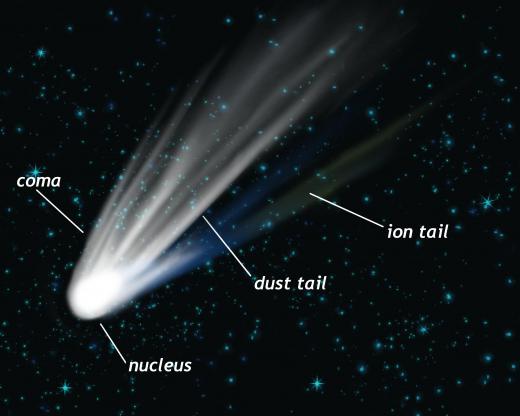What are Asteroids and Comets Made of?
 Michael Anissimov
Michael Anissimov
There are several different types of asteroid classification systems in use, making classification and referencing somewhat confusing, even to astronomers. A basic outline common to all the systems includes three categories - carbonaceous, known as the C-type, making up 85% of known asteroids, silicaceous or stony, the S-type, making up 17% of known asteroids, and metallic, called the L-type or X-type, making up the remainder at 8% of known asteroids. These types are usually broken down into various subdivisions based on spectral classification, albedo, and guesses about their composition. Some special categorization types, such as the Q, R, and V types, are so rare that they are represented by only a single asteroid.
As of 4 June, 2007, 376,537 asteroids and minor planets have been registered, with a discovery rate of approximately 5,000 new bodies per month. It is estimated that there are between 1.1 and 1.9 million asteroids with a diameter of greater than 1 km in the solar system, and many billions with a diameter greater than 10 m. Despite its depictions in fiction, the asteroid belt between the orbit of Mars and Jupiter is not extremely dense - it just contains more asteroid density than any other portion of the solar system. Imagine a body only 1/1000th the size of Earth broken up into little pieces and strewn throughout a huge area slightly larger than the Martian orbit. That's the asteroid belt. Because of the way the Solar System's bodies interact gravitationally, this region is a "sweet spot" for debris to end up in.

Comets, despite their reputation as luminous bodies, are actually among the darkest objects in the solar system, reflecting only 3% - 5% of incoming light. By comparison, asphalt reflects 7% of light. This blackness stems from organic compounds that comets are made of - long-chains of carbon-containing molecules, such as hydrocarbons. Imagine a ball of material similar to oil or coal. Comets also contain large amounts of ice and dust. For most of their careers, comets are pitch black - it is only when they closely approach the Sun that their magnificent ion tails are unfurled. Most comets have highly elliptical orbits, coming close to the Sun for only a few months and spending hundreds or thousands of years in the deep solar system.

The high carbon content of asteroids and comets could come in handy for future space colonization efforts. In the future, asteroids could be disassembled and processed to create molecular feedstock for gardens in space colonies. Nitrogen would still need to come from planets or moons, though.
AS FEATURED ON:
AS FEATURED ON:














Discussion Comments
Um, the percentages of known types of asteroids add up to over 100 percent.
Post your comments